|
Louis Sidney (Sid) Le Protti (November 25, 1886 to August 30, 1958) |
 Known Composition Known Composition |
|
Unattributed contribution to Canadian Capers (1915)
|
Pruning and trimming the family tree of Barbary Coast pianist Sid Le Protti took a great deal of careful searching with some interesting discoveries. Some of his background is presented here for the first time, along with some clarifications on questions that have been asked about his life and heritage. We need to go back at least one generation more to fully appreciate that heritage.
Sidney's maternal grandmother was freeborn Amelia Gibbs, born in Pennsylvania around 1845 to Sarah A. Gibbs.
By the time of the 1870 census, Sarah had been widowed and Amelia had been either widowed or divorced, her last name now Dangerfield. She had three daughters, Elizabeth (1864), Hattie (1866) and Amelia (8/1868). At that time Sarah and the older Amelia had moved from Pennsylvania to San Francisco where they worked as dress makers. In 1872 the elder Amelia had remarried (reportedly her fourth time) to Jamaican immigrant Richard Marsden, and as of the 1880 census the younger Amelia had gained three younger siblings, William (1873), Joseph Henry (1875) and Alice (1880). Also in that census and recently immigrated from Italy was Louis Le Protti (possibly Leprotti or a variation on the more common Liberatti) working as a day laborer.
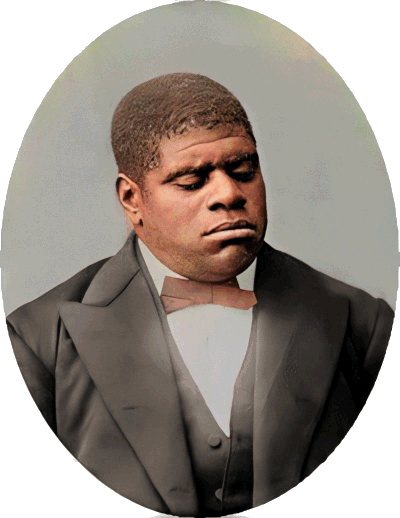 |
At some point in the mid-1880s Louis had an affair with Amelia, who was only 17 to Louis' 28, and in November of 1886 she gave birth to a possibly illegitimate mulatto child, Louis Sidney Le Protti. No record of marriage has been found for the couple, but in fairness it could have been among the many records lost in the 1906 San Francisco earthquake and fire. As Sid put it, "I was born Thanksgiving Day, 1886, at 3:15 in the afternoon. I was the guy that spoiled the turkey... I heard [his grandmother] tell several friends of the family, 'That's the pop-eyed rascal that burned up my turkey."
Sidney was mostly raised by his maternal grandparents. For the 1900 enumeration, Amelia showed as married, yet using her maiden name of Dangerfield, and adding two years to her age, possibly to avoid being known for having had a teenaged pregnancy. She and Louis Jr. were living with her stepfather and mother in Oakland, with Richard working as a janitor and the elder Amelia as a midwife. By that time Louis had moved south to Santa Clara, California, and was working as a farm laborer. So Louis Sidney Le Protti Jr., who was shown as Sidney in the 1900 record (possibly so as to not directly reference his father), grew up as a mixed race child in a black family with no father present. Sidney does mention his father as a harp player, so Louis may have spent some of his time with the family when not working.
According to Le Protti he first heard ragtime around 1895. A youth named Leroy Watkins came to the Marsden residence and played early ragtime tunes on their Stedman & Company square grand piano. Partially hooked, he heard pianist "Blind Tom" Wiggins in a church concert in Oakland in the late 1890s, and the legendary John William "Blind" Boone within a few more years. But even before those events Sidney had been taking some classical piano from a German music teacher thanks to his grandparents, both of whom were also musical. While he did not particularly care for it, in later years he understood how beneficial a foundation it laid for his later work and that of other jazz pianists.
His teacher sensed his reluctance, saying pretty much after hearing some of his practiced works, "If you won't play it right, then leave it alone. She then told his grandmother as much, which caused her to double down on Sid until he got it right.
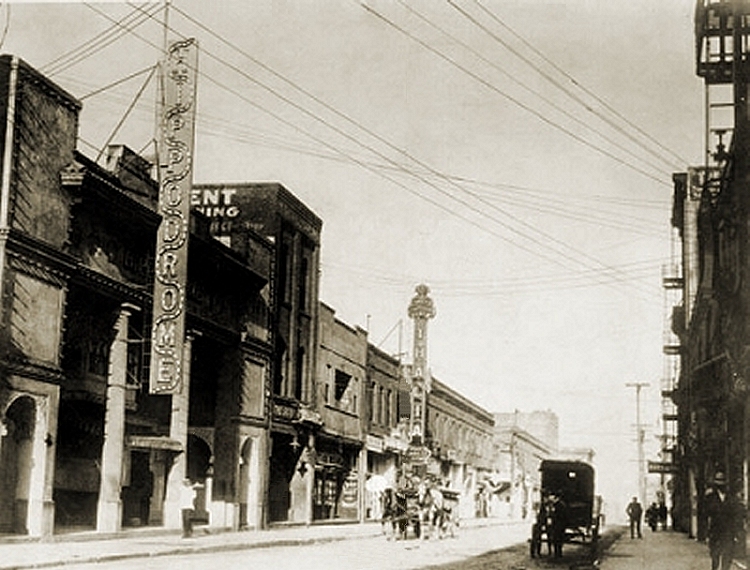 |
A common promotional tool for publishers in the late 1890s and early 1900s was to release a free Sunday supplement in the papers of a piece, hoping it would encourage purchases of other works by those composers or the same publishing house. Around 1897 the San Francisco Examiner printed the 1896 piece Ambolina Snow (an Afro-American Military Ballad), music by George D. Brainard, which had some light syncopation in it. Sidney was proficient enough to read the score. His uncle Joseph heard the piece and immediately went to the elder Amelia, proclaiming that "Sid is playin' ragtime." Sidney was quickly reprimanded for this infraction, but after a discussion with a German friend of the family, Lorenzo, who also happened to be a dancer, they ascertained that perhaps it was not such a bad thing, so they allowed and even encouraged him to continue. This emboldened the lad, now in his early teens around 1901 or so, to procure a gig in an Oakland dance hall, despite only knowing Ambolina Snow, Maple Leaf Rag and Peaceful Henry. He claims to have made it work, interspersing the scant rag repertoire with some of the classical pieces he had learned along the way. In addition to this, after his grandmother died, he worked in an iron works in Emeryville operating a roller mill creating wrought iron. He sustained several burns on his hands and arms, but somehow managed to escape any major injury.
Sid soon started playing his way through a number of venues in small Bay Area towns like San Pablo, Angels Camp and Salinas. It was then that a "fella named [Henry] Stewart" came into his life. He ostensibly said, "You know, you can play all the music in the world, but you ain't playin' nothin'. That music is just mechanical!" He encouraged Le Protti to not just rely on the memorized notes, but to start listening to and working with other pianists (who were evidently mostly quite accepting on the West Coast), and learn to improvise, and pick up songs through simple ear training. Sid later said this changed his entire life. "No matter how old you are, two heads is better than one... and you know you can always learn some more."
Across the bay in San Francisco, the Barbary Coast had been a part of San Francisco since the days of the gold rush in the 1850s. Located around the base of Broadway and Pacific Avenue (sometimes referred to as Pacific Street) near current day Jackson Square, extending to Clay Street near Montgomery Street, and named after the dangerous Barbary Coast of Africa due to its similar nature, by the late 19th Century it had earned an international reputation, both good and notorious.
It was also the primary area of prostitution for the bay city, as well as gambling and crime, but mostly adult entertainments. According to Lloyd E. Benjamin in an 1876 book, Lights and Shades of San Francisco, "The Barbary Coast is the haunt of the low and the vile of every kind. The petty thief, the house burglar, the tramp, the whoremonger, lewd women, cutthroats, murderers, all are found here. Dance-halls and concert-saloons, where blear-eyed men and faded women drink vile liquor, smoke offensive tobacco, engage in vulgar conduct, sing obscene songs and say and do everything to heap upon themselves more degradation, are numerous. Low gambling houses, thronged with riot-loving rowdies, in all stages of intoxication, are there. Opium dens, where heathen Chinese and God-forsaken men and women are sprawled in miscellaneous confusion, disgustingly drowsy or completely overcome, are there. Licentiousness, debauchery, pollution, loathsome disease, insanity from dissipation, misery, poverty, wealth, profanity, blasphemy, and death, are there. And Hell, yawning to receive the putrid mass, is there also."
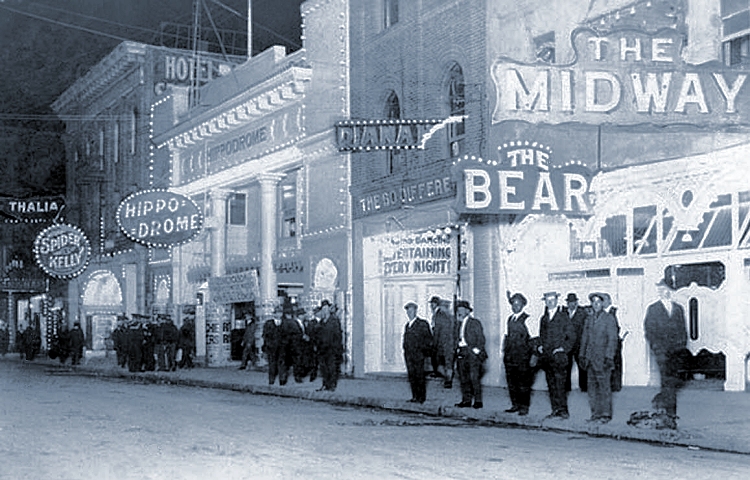 |
Not much changed up through 1906, and indeed the Barbary Coast was one of the last portals of entertainments of all kinds for those departing for the Klondike gold rush from the summer of 1897 through 1898. After the district was mostly destroyed in the 1906 earthquake and fire, there was a chance to rebuild it and improve on the tone and reputation. The rebuilding commenced, but the vice was instantly reconstituted as well. One of the primary dance halls was Purcell's So Different Café, which was founded by black entrepreneurs Lew Purcell and Sam King, formerly Pullman porters on the railroad. Their dance hall rose very soon literally out of the ashes of the fire, and after one move from Broadway was ultimately located at 520 Pacific Avenue. Le Protti noted that the locals called it or one of the side streets "Terrific Street," and remembers seeing the blaze of the electric lights as they took the ferry across from Oakland. Other establishments in the district just west of the Embarcadero, which encompasses Russian Hill, Chinatown, Union Square and Washington Square, included The Hippodrome, The Bella Union (there was a substantial Italian population in the area), The Midway, Spider Kelly's and John Parenti's Saloon.
Many nights the entire area would be shut down by the police, only to emerge from the temporary threat the next morning. It wasn't until 1914 that the city government passed legislation to start a push that would eventually shut down Barbary Coast establishments.
With driven support from local Reverend Paul Smith and a decision by the United States Supreme Court, the prostitutes and gamblers were forced out of business in 1917 almost simultaneously with the Storyville District in New Orleans. All that remained were the musicians and dance halls, and even dancing was prohibited in short order.
Le Protti was there for this entire period. Among the first establishments in which he was regularly employed was Purcell's So Different Café starting in early 1907, a year after the earthquake disaster. Although his first run there was afternoons from 2 to 6, he also had an additional day job working as a music demonstrator in a piano store, possibly a branch of Sherman & Clay, the dominant San Francisco music company. Once he started working the evening shifts, he and the house band were accompanying the female dancers that worked at the café, who would dance with the "gentlemen" that came into the club, getting .20 cents per dance, of which the band would receive half from each girl. Le Protti recalled that in order to move things along and increase their take they would play an average of 24-30 dances per hour. In the 1910 census Sid was shown living on his own in a San Francisco boarding house on Montgomery Avenue in San Francisco still working as a musician in a piano store. He was listed as a mulatto in this record, but most other times was shown as black or colored. In 1912 Sidney married Georgia transplant Mayme Richardson (sometimes incorrectly spelled Mamie). Previously married, she brought her three-year-old daughter Thelma Richardson with her.
Musicians from all over the country came to the Barbary Coast to play or listen, so Sid and his band were frequently exposed to new ideas in performance. Among those that intrigued him were both the instrumentation and four-beat playing of New Orleans' musicians, including Ferdinand "Jelly Roll" Morton and the band of Joseph "King" Oliver. However, his first true exposure to early New Orleans jass was from Will Johnson's Original Creole Orchestra. Trying to emulate that style starting around 1912,
Sid ended up weeding out the musicians who could not get a good grasp on it, and added an upright bass to help with the four-beat feel. By 1915 he had rebuilt the So Different Orchestra into one of the finest performing groups in the Bay Area, black or white. It is probable that they also used the name So Different Jazz Band in 1915, making the group potentially the first band in the country to incorporate the term jazz or jass as early as 1913 according to one 1913 newspaper mention. Sid also believed that the famous Texas Tommy Dance, typically performed to a modified version of the tune King Chanticleer, was first introduced to the West Coast at Purcell's. It originated either in Texa or possibly at Purcell's, and the Tommy name is said to have been slang for "prostitute" (which is probable, but difficult to confirm).
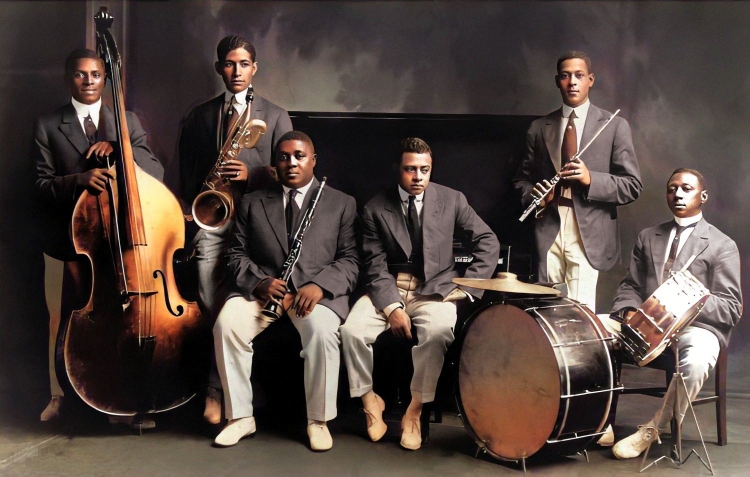 |
While Sid later recounted that he and his colleagues were generally good-hearted about teaching each other tricks, and even sharing tunes, there was on instance in which he later regretted the outcome as a result of this. It was around 1914 that itinerant Chicago pianist Glover Compton set up in the district for a while and befriended Le Protti. While there are no definitive samples in print or any registered copyrights, Compton reported that Le Protti had written several compositions of his own. One of those in particular was appealing to Compton and he quickly learned it. In 1915 during a visit to Sherman & Clay, Sid heard his tune played again by a friend who was asking him if it was familiar. It was, but this time it was part of an instrumental tune named Canadian Capers. Evidently Compton had played it back in Chicago at the repeated request (with the lure of dollar tips) of pianist Henry Cohen, and Cohen collaborated with three of his friends to compose the piece Canadian Capers around it, including Le Protti's melody in the B strain. It became a substantial hit in short order, enough to eventually warrant a song version.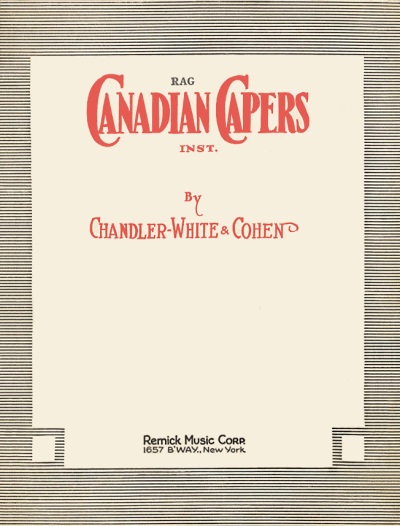 At a later time when Le Protti was performing in Los Angeles, he encountered Cohen and asked him about this. Henry pointed to Compton as the one who taught him the melody, and when asked if he could use it, Compton had no argument, implying to some extent that it was his tune. Glover Compton confirmed this story at some point as well. Sadly Le Protti had no copyright or other proof to protect him and benefit from the tune's hit status, but even when asked if he wanted an agreement, he demurred, saying "Just be careful next time.".
At a later time when Le Protti was performing in Los Angeles, he encountered Cohen and asked him about this. Henry pointed to Compton as the one who taught him the melody, and when asked if he could use it, Compton had no argument, implying to some extent that it was his tune. Glover Compton confirmed this story at some point as well. Sadly Le Protti had no copyright or other proof to protect him and benefit from the tune's hit status, but even when asked if he wanted an agreement, he demurred, saying "Just be careful next time.".
 At a later time when Le Protti was performing in Los Angeles, he encountered Cohen and asked him about this. Henry pointed to Compton as the one who taught him the melody, and when asked if he could use it, Compton had no argument, implying to some extent that it was his tune. Glover Compton confirmed this story at some point as well. Sadly Le Protti had no copyright or other proof to protect him and benefit from the tune's hit status, but even when asked if he wanted an agreement, he demurred, saying "Just be careful next time.".
At a later time when Le Protti was performing in Los Angeles, he encountered Cohen and asked him about this. Henry pointed to Compton as the one who taught him the melody, and when asked if he could use it, Compton had no argument, implying to some extent that it was his tune. Glover Compton confirmed this story at some point as well. Sadly Le Protti had no copyright or other proof to protect him and benefit from the tune's hit status, but even when asked if he wanted an agreement, he demurred, saying "Just be careful next time.".Armed with a six piece band of woodwinds and rhythm, Sidney's group often was asked to play at venues other than the Purcell's Café. They also expanded their repertoire well beyond ragtime and early jazz or barrelhouse, playing famous overtures such as Poet and Peasant, Morning, Noon and Night in Vienna, and even the now-famous William Tell Overture. One winter Sid's six piece band teamed up with that of George Bryant's who was staying in town with Ferdon's Medical Show, and they both rehearsed and performed together for a while as a twelve piece orchestra. Even King Oliver sat in on some of the groups gigs when he was in town. In the late 1910s the Le Protti group performed for C.O. Swanberg at the Porta La Louvre, and even ventured to the Pacific territory of Hawai'i to play at the Alexander Young Hotel. In 1917 Le Protti quit working regularly at the So Different Café. On his 1917 draft record, Sidney was listed as working for the much classier Portola Lounge (Café) at 18 Powell Street. Living once again across the bay in Oakland, he claimed to be the sole support for his mother, brother, wife and stepdaughter.
According to Mayme Le Protti, the advent of World War I ravaged the band and they went into the military or on their separate ways. Most of them headed to the East Coast to fill in the gaps left by others who had departed for Europe.
Sid was offered the same opportunity but declined, further straining relationships with his fellow musicians. He continued to work as an ad hoc pianist for various establishments and music groups. In order to supplement his income after the war was over, Sid set up a shoeshine stand at University Avenue and Grove (since renamed) near his home in Berkeley just blocks from the bay. Many of his customers also went to hear his newly formed band rehearse nearby in the evenings.
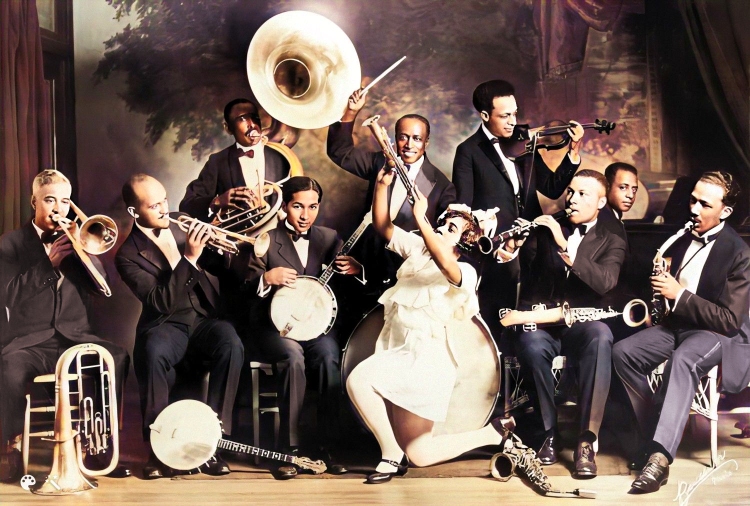 |
As conditions improved after the war Sidney was once again working in the Barbary Coast district at Purcells, now located at 468 Pacific Street, although whether it was a solo or band gig is unclear. He is shown again as a musician working a café in the January 1920, enumeration. Using his given name of Louis, he also listed his son Sidney Le Protti who was born the previous September. According to historian Rudi Blesh in the book Shining Trumpets, Oliver and his band visited Purcell's around May 1921. Knowing of their prowess and growing reputation, Le Protti felt obliged to let them play a little, and to set forth with teaching the locals what Chicago jazz was all about. According to Le Protti by way of Blesh, "When the noise stopped, I looked around for my boys. One or two crawled out from under the tables with their violins under their arms and I said, ‘Throw those cigar boxes away and get some horns.’" Since he had already been playing with a similar ensemble, this account is likely either an exaggeration or just a misplacement in his timeline.
After having shut down gambling, prostitution, dancing, and now thanks to the Volstead Act, alcohol in the district, the politicians finally delivered a crushing blow when musicians were also chased out in the late Spring of 1921, Sidney being among them. They finally went back to work, but with several restrictions on both the musicians and personnel, as well as their conduct. Purcell's was finally shut down after w New Year's Eve raid in early 1924. His family was growing, having added daughter Jacqueline to the household in 1923, so he continued to seek out work. Throughout the remainders 1920s Sid worked as a free-lance pianist, sometimes with his band, as well as doing odd jobs, also operating his Berkeley shoe-shining parlor. With steady gigs in San Francisco in short supply, Sid and his various groups would travel to smaller venues, such as Fort Bragg or Williams to the north.
They played special events, house parties, dances, and more. Definitive reports are scarce during this decade. However, in the 1930 census Sid lists himself as an orchestra musician, indicating he was still pounding the keys for a living.
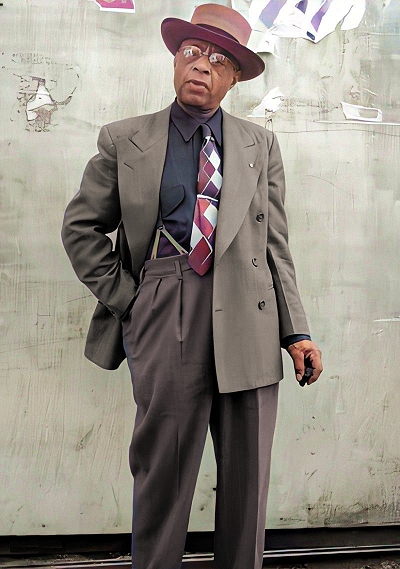 |
Even though the Barbary Coast district slowly came back to life in after the campaign to shut it down, by the mid-1930s Sid and his family had moved northeast a bit to Walnut Creek, just south of Concord. and bought a nice home on an acre of land nearby. He found steady work there playing current swing hits as well as the more nostalgic ragtime and early jazz. But it was not consistent enough for a steady income. Going back to one of his earlier skills, as per the 1940 census taken in Contra Costa, California, as Louis S. Le Protti, he was listed as a shoe shiner, rather than as a musician, having taken management or probably ownership of a shoe shining parlor and cigar store. On his 1942 draft record he is listed as self-employed, working for his establishment at 1325 Main Street in Walnut Creek, probably his aforementioned business. It was in this town in the late 1940s where Rudi Blesh encountered the once prominent Barbary Coast musician and interviewed him for his 1946 jazz history, Shining Trumpets. Portions of that interview were also used in They All Played Ragtime published in 1950. While neither gave much celebrity to Le Protti, they did at least bring a few curious jazz aficionados to the Bay Area to seek him out, and this allowed him to keep performing into his late sixties. The 1950 enumeration taken in Contra Costa County in California showed Sid working as a maintenance person for Pacific Gas and Electric.
White San Francisco trumpeter Lu Watters, aided by pianist Wally Rose and trombonist Turk Murphy, had led a revival of traditional jazz that underwent a tentative start in 1942, but picked up again after the war in 1946. Playing in institutions like the Dawn Club, not all that far from the old Barbary Coast, they further helped the movement that led to Blesh's book and the rediscovery of artists such as Le Protti. In 1952 Murphy, along with George Avakian of Columbia Records, sat down with Le Protti and recorded many of his recollections included here. They include perhaps the only remaining samples of Le Protti's playing, which at 66 years of age was still considerable and suggested a wide repertoire. The recording was intended for a record release which never transpired. Sidney Le Protti passed on in Contra Costa, California in 1958. While his legacy is largely the memory of some legendary years on the San Francisco Bay, and the stolen melody used in Canadian Capers, it should in no way be regarded as a minimal contribution to ragtime and early jazz, West Coast style. As 66-year-old Sid claimed in his Avakian interview, "The [Barbary] Coast is gone, but it didn't take me with it."
Some of the information here can also be found in Tom Stoddard's fine book Jazz on the Barbary Coast, highly recommended for anyone who wants to extend their ragtime library. Some Le Protti excerpts are from the 1952 interview with George Avakian and Turk Murphy, available in full on YouTube, and the Spring, 1998 edition of the Frisco Cricket. The rest of the information was uncovered by the author through extensive searches using various spellings in newspapers, periodicals, public records and accounts by other musicians.